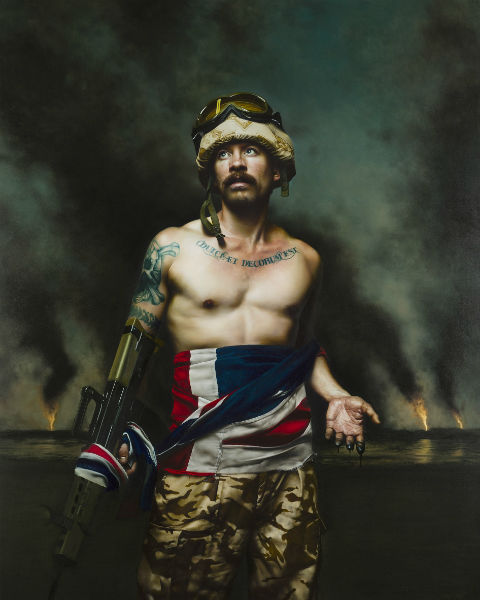
Painter Mitch Griffiths is contributing to the celebrations commemorating the First Armistice at Compiègne, which ended WWI fighting across Europe in 1918. The extraordinary painting is on display at Halcyon Gallery in London starting today.
While executed in Griffiths’ signature hyper-realist style, Call of Duty (2014) features an allegorical figure, a personification of the tragedy of wars past and present. It pictures a soldier standing in front of Iraq’s burning oil fields. On his chest, are tattooed the words “Dulce et decorum est” (It is Sweet and Right), taken from the title of a WWI poem by Wilfred Owen.
Call of Duty is part of the artist’s “Higher Powers” series, which will be shown in an exhibition slated for 2015 at Halcyon Gallery Mayfair.
artnet News caught up with Griffith to find out more about the work.
How did you get started on the Higher Powers series?
This series looks at ideas I have been having regarding the triumph of the human spirit set in contrast to the more tangible authority held by various institutional or governmental structures of human society. The struggle for power can be found in the everyday rat-race or in the upper echelons of global politics. The receipt of inspiration, or spark to do something great, is unanimously mysterious and is sought in the mundane and the sublime.
At what point did the Wilfred Owen poem come into play?
The poem seemed fitting to include, as its sentiment is of nobility, sacrifice, and the visceral, horrific reality of war. Owen himself died in action, which of course gives the poem greater poignancy.
How did you come up with the composition for Call of Duty? Can you talk us through your working method for this piece?
For this piece I had a model in mind, but the composition and pose came about by experimenting in the studio. I was after a certain gesture, but sometimes I am not entirely sure what I want until it is achieved. The figure’s pose exudes a sense of nobility while displaying an aura of desperation. He seems to be in conflict over what is expected of him as a soldier, and perhaps the greater expectation of his morality as a human being.
For the environment of the piece, I wanted to reference the burning oil fields of Iraq, which is echoed in the oil dripping from his fingers. The painting is questioning the motives for going to war and the subsequent spoils of military intervention. The sight on his rifle has been modified to resemble the Islamic star and crescent to further comment on the perceived enemy, and the propaganda we are fed in order to justify foreign policy. Some people seem to think we are fighting a religion, which isn’t the case. This is why it was important to have these two elements in each hand.
How often does literature inspire your work?
I’ve never really used literature to directly inspire my work. The process of generating ideas is usually a form of social commentary or at least a reaction to what is going on.
Can you tell us about your working process for this series?
I first start amassing different ideas, expand upon them and then explore different imagery while considering different models for certain works. Then once things have coalesced I concentrate on individual pieces, whilst trying to remain mindful of the series as a whole. The whole series, in a way, should work as a piece in itself, or at least a concept in itself.